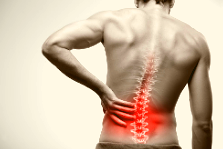Anatomy
Position. The lumbar vertebrae form part of the spine, or rachis, a bony structure located between the head and the pelvis. The spine is the skeletal base of the trunk, located dorsally and along the midline. It starts below the skull and extends into the pelvic region (1). The spinal column consists of an average of 33 bones, called vertebrae (2). These bones are connected to each other to form an axis, which has a double S-shape. The lumbar vertebrae, of which there are 5, form a forward-facing curve (3). They form the lumbar region of the lower back and are located between the thoracic vertebrae and the sacrum. The lumbar vertebrae are called L1 to L5.
Structure. Each lumbar vertebra has the same basic structure (1)(2) :
- The body, the ventral part of the vertebra, is voluminous and solid. It carries the weight of the skeletal axis.
- The vertebral arch, the dorsal part of the vertebra, surrounds the vertebral foramen.
- The vertebral foramen is the central, hollowed part of the vertebra. The stack of vertebrae and foramina forms the vertebral canal, which is crossed by the spinal cord.
Joints and insertions. The lumbar vertebrae are connected to each other by ligaments. They also have several articular surfaces to ensure their mobility. Intervertebral discs, fibrocartilages comprising a nucleus, are located between the bodies of neighboring vertebrae (1)(2).
Musculature. The spinal column is covered by the musculature of the back.
Functions of the lumbar vertebrae
Supportive and protective role. The lumbar vertebrae, which make up the spinal column, help support the head and protect the spinal cord.
Role in mobility and posture. The lumbar vertebrae make up the spinal column and help maintain the trunk's posture and thus maintain the standing position. The structure of the vertebrae allows many movements such as torsion of the trunk, bending of the trunk or traction.
Pathologies and associated problems
Back pain. It is defined as a localized pain most often originating in the spine and generally affecting the muscle groups surrounding it. Low back pain is localized pain in the lumbar region. Sciatica, characterized by pain starting in the lower back and extending into the leg. Common, they are due to compression of the sciatic nerve, which can sometimes be caused by the lumbar vertebrae. Different pathologies can be at the origin of these pains (4):
- Degenerative pathologies. Osteoarthritis is characterized by wear and tear of the cartilage protecting the bones of the joints. (5) Disc herniation corresponds to the expulsion at the back of the intervertebral disc nucleus by wear and tear of the latter. This can result in compression of the spinal cord or sciatic nerve.
- Deformations of the spine. Deformations of the spine can occur. Scoliosis is a lateral displacement of the spine (6). Lordosis is associated with an accentuated curvature of the lumbar vertebrae. (6)
- Lumbago. This pathology is due to deformations or tears of the ligaments or muscles located in the lumbar vertebrae.
Treatments
Drug treatments. Depending on the diagnosed pathology, certain medications may be prescribed as painkillers.
Physiotherapy. Back re-education can be carried out with physiotherapy or osteopathy sessions.
Surgical treatment. Depending on the diagnosed pathology, surgery may be performed on the lumbar region.
Exploration and examinations
Clinical examination. Observation of back posture by the physician is the first step in identifying an abnormality.
Radiological examinations. Depending on the suspected or proven pathology, additional examinations may be performed such as an X-ray, ultrasound, CT scan, MRI or CT scan.
Anecdote
Research work. Researchers at an Inserm unit have reportedly succeeded in transforming adipose stem cells into cells that can replace intervertebral discs. The goal of this work is to renew the worn intervertebral discs, which cause certain lumbar pains. (7)


Post A Comment:
0 comments so far,add yours